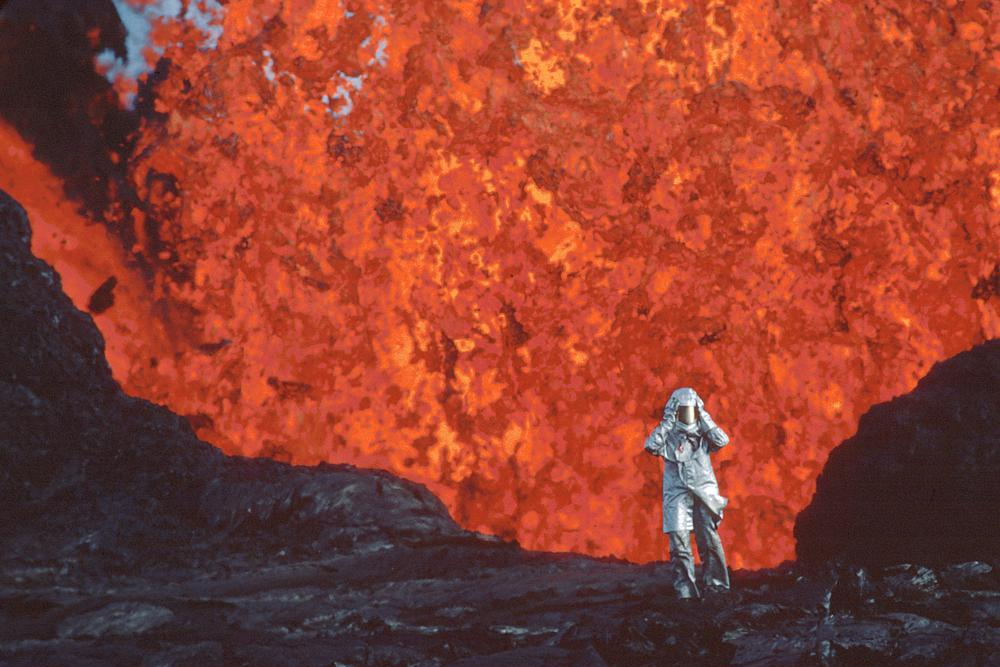
There is a curious love triangle that sits at the center of the new documentary “ Fire of Love.” It’s between a man, a woman and a volcano. Well, all volcanoes really.
The names might not be especially well-known today, but in the 1970s and ’80s, French scientists Katia Krafft and Maurice Krafft were to volcanoes what Jacques Cousteau was to oceans. The married couple traveled the world for some 20 years in pursuit of their studies, capturing the spectacles with 16mm cameras and writing colorfully about their findings until their deaths in 1991 on Mount Unzen in Japan. On that June day a current of gas and volcanic matter called a pyroclastic flow took 43 lives, including the Kraftts and American volcanologist Harry Glicken.
Their deaths were covered globally, but their story has somewhat receded in the popular imagination in the past three decades, though Werner Herzog did spotlight them in his 2016 documentary “Into the Inferno.”
Filmmaker Sara Dosa stumbled upon the Kraffts while making an earlier film about Iceland. The Kraffts, who first bonded over Mount Etna and Mount Stromboli and were married in 1970, witnessed some 140 eruptions on every continent except Antarctica and won an Emmy for their National Geographic documentary “Mountains of Fire.” They would famously drop everything to get to an active volcano, and were often the first on site. They were also known for their willingness to get dangerously close.

When the pandemic scuttled plans for another project, Dosa remembered this fascinating couple and the stories about their hundreds of hours of disarmingly beautiful footage of active volcanoes.
“I’m endlessly curious and just fascinated by how humans make meaning out of non-human nature,” Dosa said. “I feel like I got to see that in their works so beautifully.”
And she set out to make something about the Kraffts in the spirit of the Kraffts. “Fire of Love,” from National Geographic Documentary Films and Neon, opens in theaters in New York and Los Angeles on Wednesday and more cities in the coming weeks.
With the help of Image’Est, an archive house in Nancy, France, and Maurice Krafft’s brother, Bertrand Krafft, Dosa and her collaborators were able to get remote access to over 180 hours of 16mm footage shot by the Kraffts and start piecing the story together. A line written by Maurice Krafft in one of his books helped justify something Dosa was already onto: That this was a love story.
“I wanted to be guided by Katia and Maurice first and foremost,” Dosa said. “They were so playful and full of humor. Their banter is infectious. They’re also philosophical. In their writings and recordings, they wrestle with themes of existentialism.”
Taking inspiration from the time when the Kraffts were coming of age, Dosa and her team decided to draw on the aesthetics of French New Wave films to help inform the tone and style of their film, including playful split screens and zooms. Even their writings, Dosa said, reminded her of the narration in François Truffaut films. So they leaned into the absurdity and profundity of this strange love triangle with a “deadpan curious” narration by Miranda July and an original “retro-futuristic” score from Nicolas Godin of the French music duo Air.

“It was important to us to, of course, tell a story that’s factual, that was accurate and reflected their lives and lived experience. And at the same time, we wanted to tell a story that felt true,” Dosa said. “But there’s kind of a true spirit to Katia and Maurice that extends beyond the literal factual.”
In other words, “Fire of Love” is anything but a filmed Wikipedia page. The film even begins with credits starring “Katia and Maurice Krafft.”
“We wanted to kind of lean into that idea of them playing themselves from an early stage. We see them as the authors of their own myth and this as kind of a mythic love story,” Dosa said. “This is a co-creation, shot by them and starring them. We’re just kind of stringing along the pieces of their life for the audience to connect with.”

















